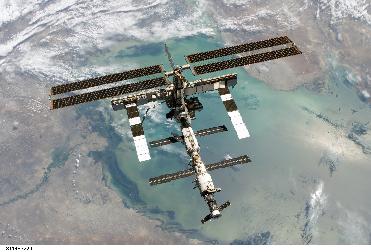
WASHINGTON (BNS): Astronauts flying aboard the International Space Station (ISS) witnessed a beautiful display of noctilucent (NLC) or "night-shining" clouds, July 22. While on board ISS, nearly 340 km over western Mongolia, the astronauts took the images of NLC.
Looking at these images, Atmospheric scientist Gary Thomas of University of Colorado said that the current NLC pictures are lovely "And it shows just how high these clouds really are, at the very edge of space."
Describing the view, Thomas said that according to an average the electric-blue band was 83 km above Earth's surface, higher than 99.999 per cent the planet's atmosphere. “The sky at that altitude is space-black. It is the realm of meteors, high-energy auroras and decaying satellites,” the Colorado scientist said.
Elaborating on the happenings in the sky, Thomas said that the Persian clouds appeared on July 19th, just three days before the ISS captured the view from latitude 38o N. He said that the images were taken ‘pretty far south’ but there existence is a puzzle waiting to be solved. Trying to evaluate their appearance, the scientist said that they may be the signs of climate change? "The first sightings do coincide with the Industrial Revolution, but the connection is controversial," Thomas said.
NASA with the help of AIM satellite, launched in April 2007, is monitoring the size, shape and icy make-up of NLCs. According to Thomas, an AIM co-investigator said that though the mission is in its early stages, it has sent in some data.
AIM states that NLCs appear throughout the polar summer, are widespread, and are highly variable on hourly to daily time scales. A film made by AIM on this spectacular visual reflects the 2007 NLC season unfolding over North Pole.
Secondly, AIM deals with the large invisible NLCs, which according to Thomas are made of tiny ice crystals 40 to 100 nanometers wide, just the right size to scatter blue wavelengths of sunlight. It is said that ISS recently detected cluster of much smaller ice crystals (< 30 nm) that don't scatter much sunlight. The Colorado scientist said that clouds made of these smaller crystals are stealthy and hard to see, but a major part of the bigger picture.
Thirdly, AIM cameras have successfully resolved some shapes of NLCs in tropospheric clouds near the Earth's surface. The AIM team has described the similarities as amazing. Comparing with earlier findings the scientists are of the view that the changes in the weather at the edge of space may not be as bizarre as known. Though the findings are new and important, they don't hold answer to the major question troubling scientists on ‘Why did the NLCs first appear in the 19th century?’
The AIM study has been extended by three years (2009-2012), and they will focus on ‘What is ice doing in a rarefied layer of Earth's upper atmosphere that is one hundred million times dryer than air from the Sahara Desert?’ Justifying the extension, Thomas said that by spending more time in orbit and gathering more data will help in unraveling these questions. Till one gets answers, it's a beautiful mystery at the edge of space.
 Previous Article
Previous Article Next Article
Next Article













The Indian Air Force, in its flight trials evaluation report submitted before the Defence Ministry l..
view articleAn insight into the Medium Multi-Role Combat Aircraft competition...
view articleSky enthusiasts can now spot the International Space Station (ISS) commanded by Indian-American astr..
view article